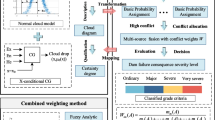Abstract
Considering the limitations existing in the single-effect quantity analysis method of dam service behavior reasoning, the dam service behavior multi-effect quantities fusion reasoning model is built and implemented based on the study of improved methods about classic Dempster–Shafer (D–S) evidence fusion technologies. Focusing on the problems that classic D–S evidence fusion rules fail or the reasoning results are contrary to the intuition and convention due to the high-conflict evidences, the calculation methods of compatibility coefficient measurement matrices between any two basic probability assignment functions of evidences (E-BPAF) and between any two basic probability assignment functions of focal elements (FE-BPAF) are provided, respectively, based on the compatibility analysis of any two E-BPAFs and any two FE-BPAFs. The weight matrices about any two E-BPAFs and any two FE-BPAFs for initial BPAFs are defined, respectively, through compatibility coefficient matrices. Then, the comprehensive weight matrix for initial BPAFs is introduced to unify weight matrices. By analyzing and comparing some examples and existing study results, the performance test of the proposed method is conducted and the correctness and rationality are also verified. Finally, combining with an instance of a gravity arch dam project, the proposed method is utilized to fuse the multi-information from measuring points on the dam abutment, and the reasonable reasoning results are obtained about the dam service behavior.






Similar content being viewed by others
References
Abellán J, Masegosa A (2008) Requirements for total uncertainty measures in Dempster–Shafer theory of evidence. Int J Gen Syst 37:733–747
Basir O, Yuan X (2007) Engine fault diagnosis based on multi-sensor information fusion using Dempster–Shafer evidence theory. Inf Fusion 8:379–386
Compare M, Zio E (2015) Genetic algorithms in the framework of Dempster–Shafer theory of evidence for maintenance optimization problems. IEEE Trans Reliab 64:645–660
Dempster AP (1967) Upper and lower probabilities induced by a multivalued mapping. Ann Math Stat 38:325–339
Esposito C, Ficco M, Palmieri F et al (2015) Smart cloud storage service selection based on fuzzy logic, theory of evidence and game theory. IEEE Trans Comput 99:1–14
Gruyer D, Demmel S, Magnier V et al (2016) Multi-hypotheses tracking using the Dempster–Shafer theory, application to ambiguous road context. Inf Fusion 29:40–56
Haenni R (2002) Are alternatives to Dempster’s rule of combination real alternatives: comments on “About the belief function combination and the conflict management problem”—Lefevre et al. Inf Fusion 3:237–239
He JP, Ma CB, Shi YQ (2012) Multi-effect-quantity fusion model of high arch dam based on improved D–S evidence theory. Geomat Inf Sci Wuhan Univ 37:1397–1400
Jousselme AL, Grenier D, Éloi B (2001) A new distance between two bodies of evidence. Inf Fusion 2:91–101
Lefevre E, Colot O, Vannoorenberghe P (2002) Belief function combination and conflict management. Inf Fusion 3:149–162
Li JW, Cheng YM, Pan Q et al (2010) Combination rule of conflicting evidence based on focal element distance. Syst Eng Electron 32:2360–2362
Li LL, Ma DJ, Wang CS et al (2011) New method for conflict evidence processing in D–S theory. Appl Res Comput 28:4528–4531
Liu W (2006) Analyzing the degree of conflict among belief functions. Artif Int 170:909–924
Liu HY, Zhao ZG, Liu X (2008) Combination of conflict evidences in D–S theory. J Univ Electron Sci Technol China 37:701–704
Ma MM, An JY (2015) Combination of evidence with different weighting factors: a novel probabilistic-based dissimilarity measure approach. J Sens. https://doi.org/10.1155/2015/509385
Moosavian A, Khazaee M, Najafi G et al (2015) Spark plug fault recognition based on sensor fusion and classifier combination using Dempster–Shafer evidence theory. Appl Acoust 93:120–129
Murphy CK (2000) Combining belief functions when evidence conflicts. Decis Support Syst 29:1–9
Rosli MF, Hee LM, Leong MS (2015) Integration of artificial intelligence into Dempster Shafer theory: a review on decision making in condition monitoring. Appl Mech Mater 773–774:154–157
Schubert J (2011) Conflict management in Dempster–Shafer theory using the degree of falsity. Int J Approx Reason 52:449–460
Sevastjanov P, Dymova L (2015) Generalised operations on hesitant fuzzy values in the framework of Dempster–Shafer theory. Inf Sci 311:39–58
Shafer G (1976) A mathematical theory of evidence. Princeton University Press, Princeton
Song YF, Wang XD, Lei L et al (2014) Measurement of evidence conflict based on correlation coefficient. J Commun 35:95–100
Song YF, Wang XD, Lei L et al (2015) Evidence combination based on the degree of credibility and falsity. J Commun 36:102–107
Su HZ, Wen ZP, Sun XR et al (2015) Time-varying identification model for dam behavior considering structural reinforcement. Struct Saf 57:1–7
Sun Q, Ye XQ, Gu WK (2000) A new combination rules of evidence theory. Acta Electron Sin 28:117–119
Yager RR (1987) On the Dempster–Shafer framework and new combination rules. Inf Sci 41:93–137
Acknowledgements
This study was funded by National Natural Science Foundation of China (SN: 51579083, 51739003, 51479054, 41323001), the National Key Research and Development Program of China (SN: 2016YFC0401601), Open Foundation of State Key Laboratory of Hydrology-Water Resources and Hydraulic Engineering (SN: 20165042112, 20145027612), the Fundamental Research Funds for the Central Universities (SN: 2015B25414).
Author information
Authors and Affiliations
Corresponding author
Ethics declarations
Conflict of interest
The authors declare that they have no conflict of interest.
Human and animal rights statement
Research do not involve human participants and/or animals.
Additional information
Communicated by V. Loia.
Publisher's Note
Springer Nature remains neutral with regard to jurisdictional claims in published maps and institutional affiliations.
Rights and permissions
About this article
Cite this article
Su, H., Ren, J. & Wen, Z. An approach using Dempster–Shafer evidence theory to fuse multi-source observations for dam safety estimation. Soft Comput 23, 5633–5644 (2019). https://doi.org/10.1007/s00500-018-3220-z
Published:
Issue Date:
DOI: https://doi.org/10.1007/s00500-018-3220-z



